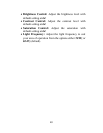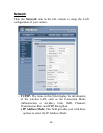
44
• WEP Encryption: Wireless network communications
can be intercepted easily. WEP (Wired Equivalent
Privacy) is an encryption method specified by the
IEEE 802.11g standard to make any intercepted
communications extremely difficult to interpret by
unauthorized parties.
The default setting for this
option is Disable.
• WEP Key Length: Select the proper setting for WEP
Encryption. In general, a larger key length creates a
stronger cipher. The default is 64-bits.
• WEP Key Format: To enable WEP Encryption, you
should decide the encryption format first by selecting
the ASCII or HEX option, and then input the WEP
key (in the following Key 1~4 box).
ASCII input format:
ASCII format causes each character you type to be
interpreted as an eight-bit value. All unaccented upper-
and lower-case Western European characters that can be
input through your keyboard's typing zone are valid. To
setup a 64-bit WEP key, input 5 ASCII characters. For
example, ‘12345’. To setup an 128-bit WEP key, input 13
ASCII characters. For example, ‘1234567890123’. These
character counts result in bit counts of 40 and 104
respectively; the camera will automatically pad your input
to a bit count of 64 or 128.
HEX input format:
Hex format causes each pair of characters you type to be
interpreted as an eight-bit value in hexadecimal (base 16)
notation. Only the digits 0 through 9 and the letters A
through F (in upper or lower case) are valid. To setup a
64-bit WEP key, input 10 HEX format. For example,
‘3132333435’, which is the same with ASCII input ‘12345’.
To setup an 128-bit WEP key, input 26 HEX format. For
example, ‘31323334353637383930313233’, which is the
same with ASCII input ‘1234567890123’. These character
counts result in bit counts of 40 and 104, respectively; the


















